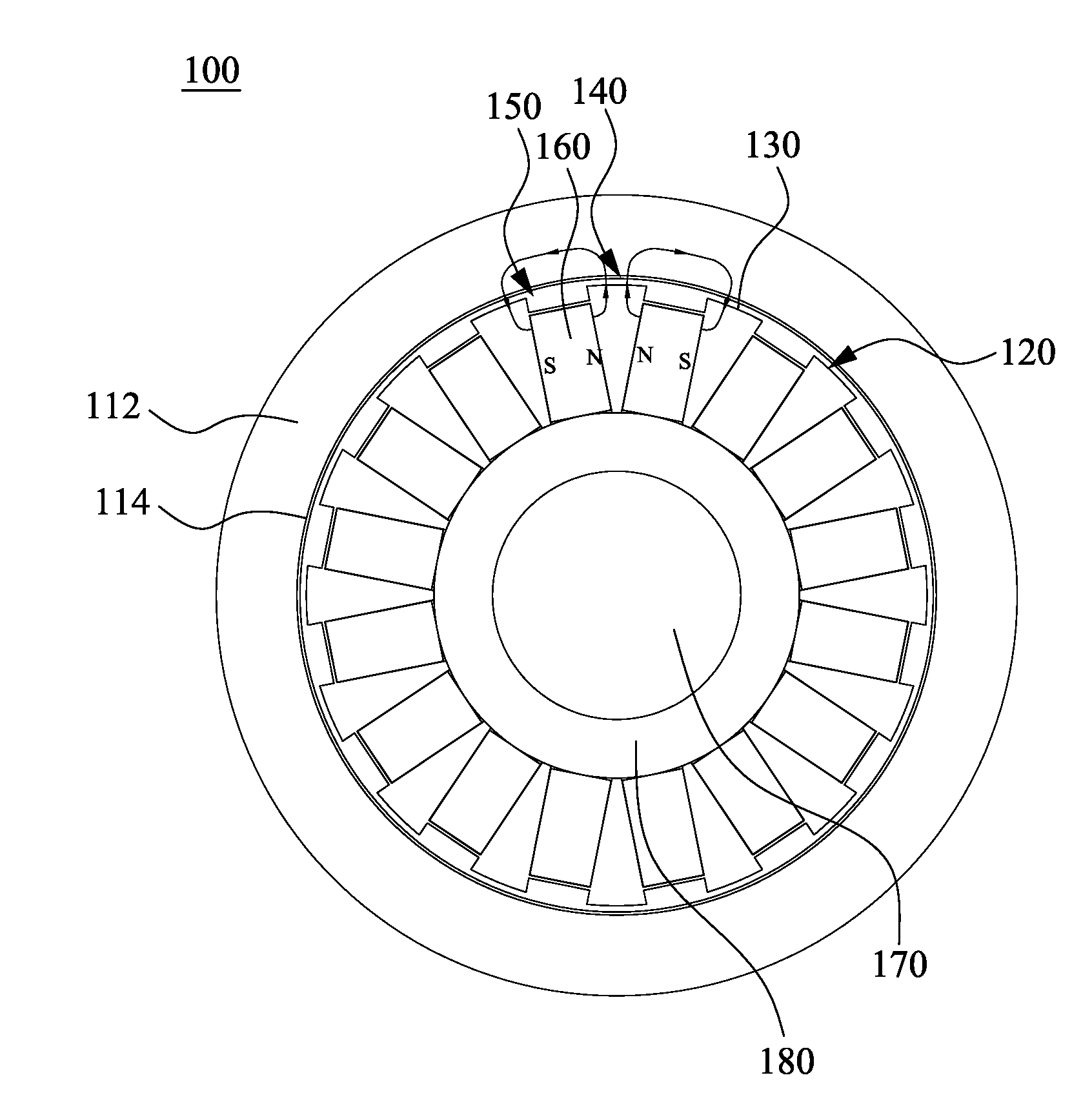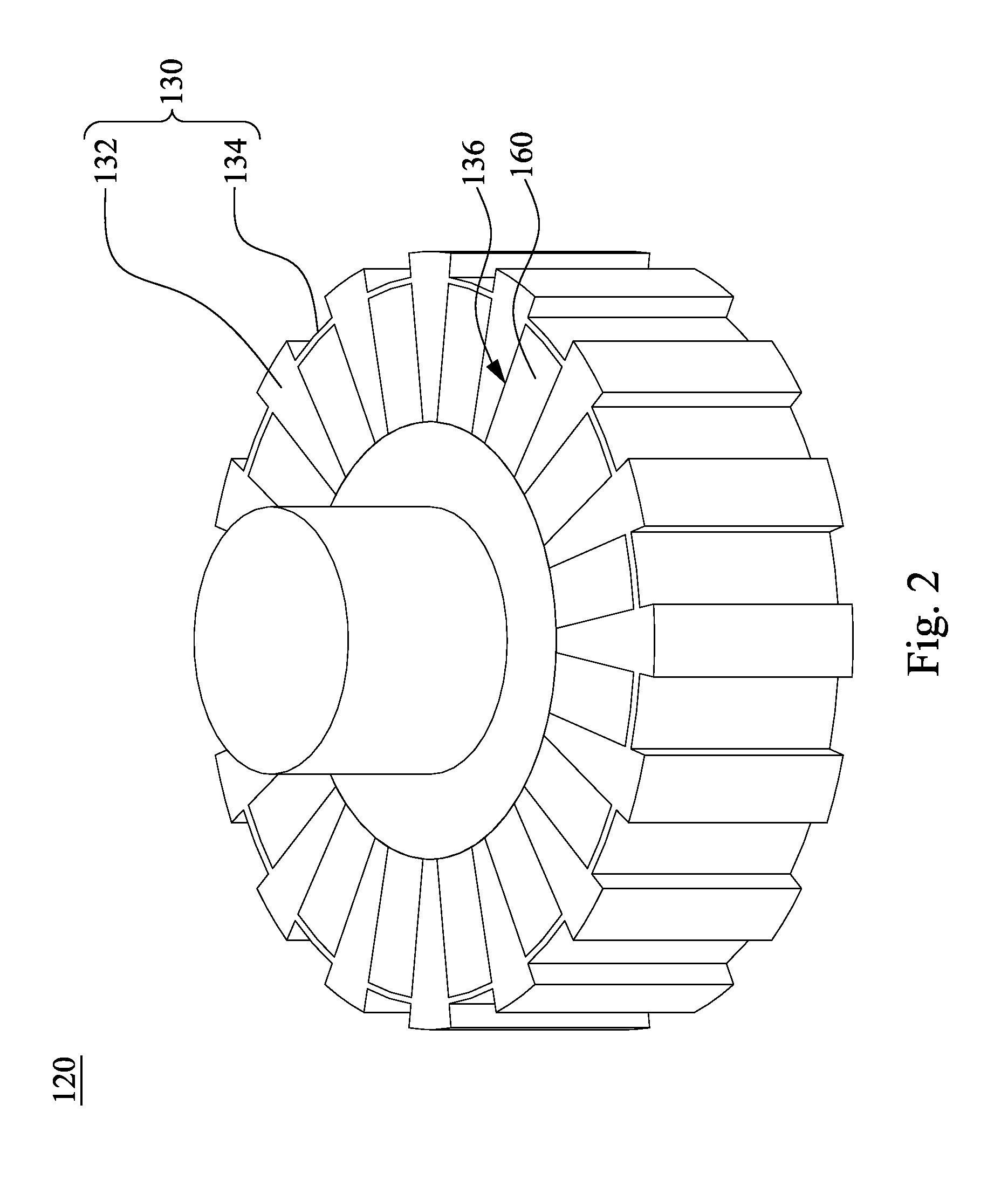Permanent magnetic coupling device
- Summary
- Abstract
- Description
- Claims
- Application Information
AI Technical Summary
Benefits of technology
Problems solved by technology
Method used
Image
Examples
first embodiment
[0025]According to FIG. 1 and FIG. 2, FIG. 1 is a schematic cross-sectional diagram of a permanent magnetic coupling device 100 according to the present invention, and FIG. 2 is a schematic 3D diagram of a permanent magnet rotor in FIG. 1. The permanent magnetic coupling device 100 includes a conductor rotor 110 and a permanent magnet rotor 120, in which the permanent magnet rotor 120 includes a magnetic ring 130. The magnetic ring 130 includes protrusions 132 and recesses 134 arranged alternately. First airflow channels 140 are formed between the protrusions 132 and the conductor rotor 110 respectively, and second airflow channels 150 are formed between the recesses 134 and the conductor rotor 110 respectively. A cross-sectional area of each of the second airflow channels 150 is greater than a cross-sectional area of each of the first airflow channels 140. A width of the each of the first airflow channels 140 W1 is in a range from 2 mm to 8 mm, and a width of the each of the second...
second embodiment
[0036]FIG. 6 is a cross-sectional schematic view of a permanent magnetic rotor according to the present invention. A permanent magnet rotor 220 includes a magnetic ring 230 including protrusions 232 and recesses 234 which are arranged alternately. First airflow channels are formed between the protrusions 232 and the conductor rotor (refer to the FIG. 1) respectively, and second airflow channels 250 are formed between the recesses 234 and the conductor rotor respectively. A cross-sectional area of each of the second airflow channels 250 is greater than a cross-sectional area of each of the first airflow channels.
[0037]The magnetic ring 230 connects to a load shaft 270. The magnetic ring 230 further includes magnetic bridges 236 disposed between the load shaft 270 and the protrusions 232. The magnetic ring 230 further includes a magnetic inner ring 238 fixed on the load shaft 270. The magnetic inner ring 238 and the protrusions 232 are connected through the magnetic bridges 236 such t...
third embodiment
[0040]FIG. 7 is a schematic 3D diagram of a permanent magnetic rotor according to the present invention. A permanent magnet rotor 320 includes a magnetic ring 330, and the magnetic ring 330 includes protrusions 332 and recesses 334 arranged alternately. First airflow channels are formed between the protrusions 332 and the conductor rotor (referring to FIG. 1), and second airflow channels 350 are formed between the recesses 334 and the conductor rotor. A cross-sectional area of each of the second airflow channels 350 is greater than a cross-sectional area of each of the first airflow channels. Permanent magnets 360 are engaged in cavities 336 disposed in the recesses 334.
[0041]In the present embodiment, the protrusions 332 and the recesses 334 are approximately parallel to each other. An angle θ is defined between the protrusions 332, the recesses 334 or the second airflow channel 350 and an axial direction of the permanent magnet rotor 320. The angle θ is from 0 to 240 / p degrees, in...
PUM
 Login to View More
Login to View More Abstract
Description
Claims
Application Information
 Login to View More
Login to View More - R&D
- Intellectual Property
- Life Sciences
- Materials
- Tech Scout
- Unparalleled Data Quality
- Higher Quality Content
- 60% Fewer Hallucinations
Browse by: Latest US Patents, China's latest patents, Technical Efficacy Thesaurus, Application Domain, Technology Topic, Popular Technical Reports.
© 2025 PatSnap. All rights reserved.Legal|Privacy policy|Modern Slavery Act Transparency Statement|Sitemap|About US| Contact US: help@patsnap.com



